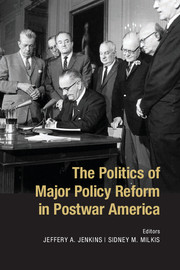Book contents
- Frontmatter
- Contents
- Contributors
- Acknowledgments
- 1 Introduction
- 2 The Long 1950s as a Policy Era
- 3 Regulation, Litigation, and Reform
- 4 Courts and Agencies in the American Civil Rights State
- 5 The Politics of Labor Policy Reform
- 6 Teachers Unions and American Education Reform
- 7 Progressive Federalism and the Contested Implementation of Obama’s Health Reform
- 8 Federalism and the Politics of Immigration Reform
- 9 Trade Politics and Reform
- 10 The Politics of Intelligence Reform
- 11 Follow the Leader
- 12 Conclusion: Madison Upside Down
- Index
- References
3 - Regulation, Litigation, and Reform
Published online by Cambridge University Press: 05 November 2014
- Frontmatter
- Contents
- Contributors
- Acknowledgments
- 1 Introduction
- 2 The Long 1950s as a Policy Era
- 3 Regulation, Litigation, and Reform
- 4 Courts and Agencies in the American Civil Rights State
- 5 The Politics of Labor Policy Reform
- 6 Teachers Unions and American Education Reform
- 7 Progressive Federalism and the Contested Implementation of Obama’s Health Reform
- 8 Federalism and the Politics of Immigration Reform
- 9 Trade Politics and Reform
- 10 The Politics of Intelligence Reform
- 11 Follow the Leader
- 12 Conclusion: Madison Upside Down
- Index
- References
Summary
More than 1.6 million lawsuits enforcing federal laws were filed over the past decade, about 97 percent of which were litigated by private parties. The suits spanned the waterfront of federal regulation, covering the policy domains of antitrust, civil rights, consumer protection, environmental law, labor, and securities and exchange. Although the United States had long relied upon private litigation to enforce federal statutes, its frequency of doing so exploded in the late 1960s. From a rate of 3 per 100,000 population in 1967 – a rate that had been roughly stable for a quarter century – it climbed to 13 by 1976, to 21 by 1986, to 29 in 1996, increasing by about 1,000 percent during these three decades. Beginning around the end of1960s, there was an utterly unmistakable explosion of private lawsuits filed to enforce federal statutes.
By the early 1980s, calls emerged in Washington for “litigation reform” in the federal system, seeking changes in federal law calculated to reduce incentives for lawsuits. I call this “anti-litigation reform.” By the 1990s, conflict over litigation reform intensified, with Republican’s predominantly arguing for anti-litigation reform and Democrats predominantly opposing them. Reduction of “frivolous” lawsuits in federal court became the central call of the anti-litigation reformers. Currently pending before Congress is the Republican-sponsored Lawsuit Abuse Reduction Act of 2011, with the goal of reducing frivolous lawsuits in federal court by increasing sanctions against those who file them. Anti-litigation reform bills have become routine in Congress, and partisan battles over the role of litigation in federal regulation have become a regular part of national regulatory politics.
- Type
- Chapter
- Information
- The Politics of Major Policy Reform in Postwar America , pp. 48 - 76Publisher: Cambridge University PressPrint publication year: 2014



